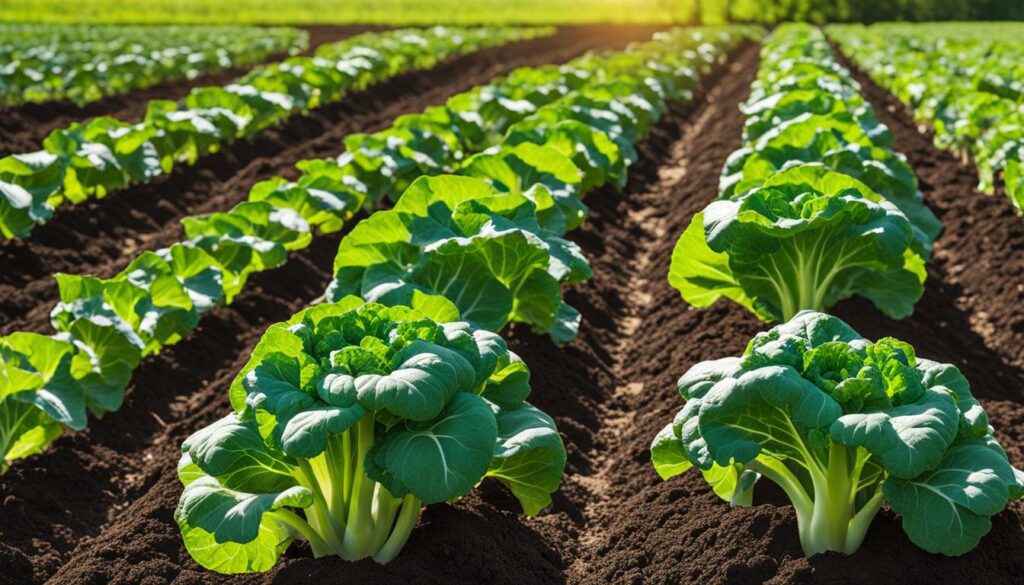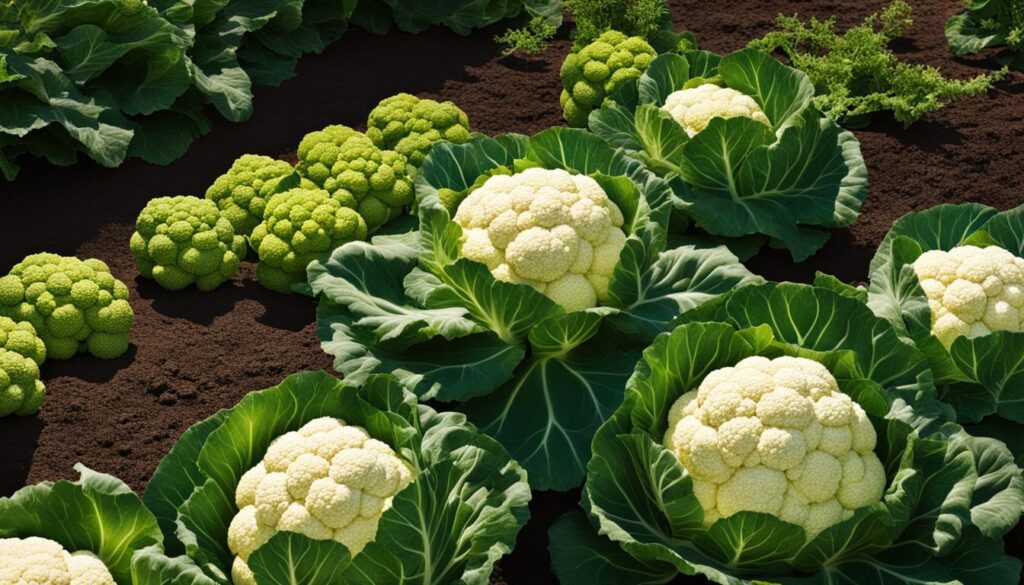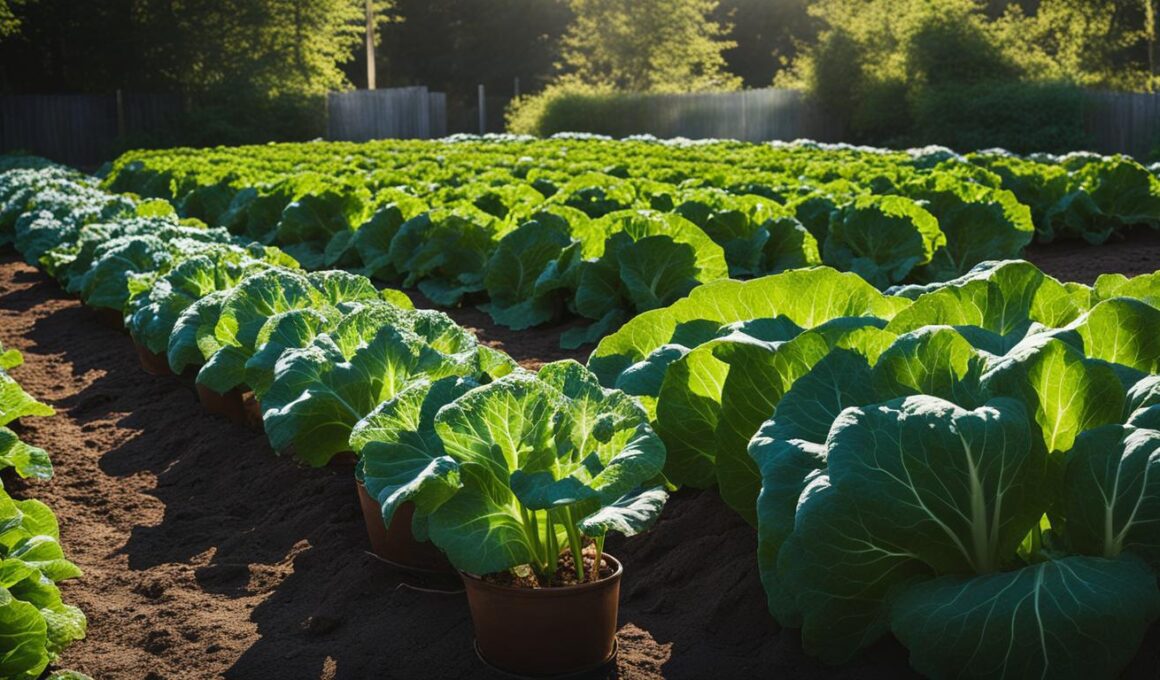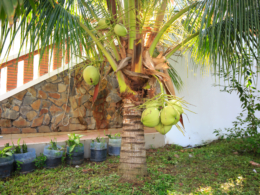Welcome to our complete guide on how to grow cauliflower and chard together as companion plants! Companion planting is an effective technique in organic gardening that can help improve garden productivity while promoting a harmonious plant ecosystem. By strategically pairing these two plants in your garden, you can reap the benefits of their mutually beneficial relationship.
In this guide, we will explore the benefits of companion planting, delve into the specific requirements of cauliflower and chard, and provide you with step-by-step instructions on successfully growing them together. Whether you’re a seasoned gardener or a beginner, this guide will equip you with the knowledge needed to create a thriving garden filled with these nutritious and delicious vegetables.
Post Summary:- Companion planting is an organic gardening technique that can improve garden productivity.
- Growing cauliflower and chard together as companion plants offers various benefits, including improved soil health and pest control.
- Cauliflower is a cool-season vegetable known for its white, round head, while chard is a leafy green vegetable packed with vitamins and minerals.
- By following the step-by-step guide provided, you can successfully grow cauliflower and chard together in your garden.
- Proper care, including sun exposure, regular watering, and fertilization, is essential for the healthy growth of cauliflower and chard.
Understanding Companion Planting and its Benefits
Companion planting is a gardening technique that involves growing two or more plant species together to take advantage of their unique abilities to benefit each other. When you grow cauliflower and chard as companion plants, you can reap several advantages for your garden.
Firstly, companion planting improves soil health. Cauliflower and chard have different root depths, which means they utilize the soil in different ways and gather nutrients from different soil layers. This helps prevent nutrient depletion and promotes overall soil fertility. Additionally, chard’s deep taproots can break up compacted soil, improving drainage and aeration for both plants.
Another benefit of companion planting is pest control. By growing cauliflower and chard together, you can create a natural barrier that deters pests. Chard leaves act as a protective shield for cauliflower, reducing the risk of pest infestations. Additionally, chard produces an aromatic scent that repels certain pests, serving as a natural pest control method for both plants.
Increased productivity is yet another advantage of growing cauliflower and chard together. Companion plants can help maximize space utilization, allowing you to grow more plants in a limited area. Additionally, chard’s foliage can provide shade and protect the roots of cauliflower from the hot sun, preventing heat stress and promoting healthier growth. The enhanced airflow between the plants also reduces the risk of fungal diseases.
Enhanced Flavor and Visual Appeal
Beyond the practical benefits, companion planting can enhance the flavor of your crops. Many gardeners report that growing cauliflower and chard together improves the taste and texture of both vegetables. The intricate interplay of nutrients and growth factors between the plants can result in more vibrant flavors and textures, making your harvests more enjoyable.
| Benefits of Companion Planting Cauliflower and Chard | Cauliflower | Chard |
|---|---|---|
| Improved Soil Health | Deep roots prevent soil depletion | Taproots break up compacted soil |
| Pest Control | Chard leaves protect cauliflower from pests | Aroma repels certain pests |
| Increased Productivity | Maximize space utilization | Shade and protection for cauliflower |
| Enhanced Flavor | Improved taste and texture | Improved taste and texture |
Overall, companion planting cauliflower and chard offers a range of benefits that can help you grow healthier, tastier crops while maximizing the productivity of your garden. By understanding the symbiotic relationship between these plants, you can create a thriving and visually appealing garden space.
Getting to Know Cauliflower and Chard
When it comes to growing cauliflower and chard together, it’s important to understand the unique characteristics of these two plants. Cauliflower is a cool-season vegetable that belongs to the Brassica family. It is known for its distinctive white, round head and is closely related to broccoli, cabbage, and Brussels sprouts. On the other hand, chard is a leafy green vegetable that belongs to the Chenopodiaceae family, which also includes beets and spinach. Chard is packed with vitamins and minerals, including vitamins A, C, and K, as well as iron and calcium.
As a cool-season vegetable, cauliflower thrives in cooler temperatures and can tolerate a light frost. It is typically grown as an annual crop and requires a longer growing season compared to some other vegetables. Chard, on the other hand, is a hardy leafy green that can tolerate a range of temperatures and is often grown as a biennial crop. Both cauliflower and chard are versatile and can be enjoyed in a variety of dishes, making them popular choices for home gardeners.
To successfully grow cauliflower and chard together, it’s essential to provide them with the right growing conditions and care. This includes ensuring they have adequate sunlight, proper watering, and suitable soil conditions. With the proper knowledge and attention to detail, you can enjoy a bountiful harvest of these nutritious and delicious vegetables.
Cauliflower and Chard: A Quick Comparison
| Cauliflower | Chard |
|---|---|
| Cool-season vegetable | Leafy green vegetable |
| Known for its white, round head | Leaves are the main edible part |
| Belongs to the Brassica family | Belongs to the Chenopodiaceae family |
| Requires a longer growing season | Can tolerate a range of temperatures |
| Packed with vitamins and minerals | Rich in vitamins A, C, and K, as well as iron and calcium |
As you can see, cauliflower and chard have their own unique characteristics and growing requirements. By understanding these differences and providing them with the necessary care, you can create an ideal environment for these companion plants to thrive and produce a successful harvest.
The Benefits of Growing Cauliflower and Chard Together
Growing cauliflower and chard together as companion plants offers several mutual benefits that can enhance the success of your garden. By understanding these benefits, you can maximize the productivity and health of both plants.
Shading and Protection
One of the key advantages of growing cauliflower and chard together is the shading and protection they provide for each other. The large leaves of chard can create shade for the delicate cauliflower heads, protecting them from the scorching sun. This sheltered environment can prevent the cauliflower from developing brown spots, ensuring their quality. Additionally, the chard’s sturdy growth can serve as a physical barrier, shielding the cauliflower plants from strong winds and potential damage.
Moisture Retention
Cauliflower and chard have different moisture requirements, but when grown together, they can help each other retain moisture in the soil. The broad leaves of chard act as mulch, reducing evaporation and keeping the soil consistently moist. This is especially beneficial during hot and dry periods, as it helps prevent drought stress for both plants. By working together, cauliflower and chard can thrive even in challenging weather conditions.
Pest and Disease Control
Another advantage of growing cauliflower and chard together is their combined ability to deter pests and diseases. Chard leaves contain natural compounds that repel pests such as aphids and beetles, which are common threats to cauliflower. By interplanting these two crops, you can create a natural pest barrier that helps protect the cauliflower. This reduces the need for chemical pesticides, promoting a healthier and more environmentally friendly garden.
Nutrient-Rich Compost
Both cauliflower and chard are considered heavy feeders, meaning they require a significant amount of nutrients to grow and produce bountiful harvests. By growing them together, you can take advantage of their nutrient needs and create nutrient-rich compost. As the plants grow and mature, their leafy greens can be added to a compost pile or used as mulch. This will decompose over time, enriching the soil with organic matter and providing a nutrient boost for future crops.
| Cauliflower | Chard | |
|---|---|---|
| Shading and Protection | Provides shade for delicate heads | Offers sturdy growth as a physical barrier |
| Moisture Retention | Helps retain moisture in the soil | Acts as natural mulch, reducing evaporation |
| Pest and Disease Control | Repels pests and reduces the need for pesticides | Deters pests and protects cauliflower plants |
| Nutrient-Rich Compost | Contributes to nutrient-rich compost | Enriches soil with organic matter |
By harnessing the mutual benefits of growing cauliflower and chard together, you can create a thriving garden that produces abundant, healthy crops. The combination of shading and protection, moisture retention, pest and disease control, and nutrient-rich compost makes these companion plants an excellent choice for any gardener. Try interplanting cauliflower and chard in your garden and enjoy the rewards of this beneficial partnership.
Step-by-Step Guide to Growing Cauliflower and Chard Together
Growing cauliflower and chard together as companion plants requires careful planning and execution. Follow these steps to ensure healthy plant starts, proper spacing, adequate watering, regular fertilization, and temperature considerations:
1. Start with Healthy Plant Starts
Begin by obtaining healthy plant starts either from a nursery or by starting your own from seed. Look for strong and disease-free seedlings to ensure a good start for your plants.
2. Determine Proper Spacing
When planting companion plants like cauliflower and chard, it is crucial to provide adequate spacing to allow proper growth and nutrition absorption. Space cauliflower transplants 12-18 inches apart, giving them room to develop their large heads. For chard, plant the transplants around the outer edges of the bed, spacing them 8-12 inches apart.
3. Ensure Adequate Watering
Cauliflower and chard require consistent moisture to thrive. Water the plants thoroughly after planting, and monitor the soil moisture regularly. Aim to keep the soil moist but not waterlogged, as excess moisture can lead to root rot.
4. Regular Fertilization
Both cauliflower and chard are heavy feeders and benefit from regular fertilization. Apply a balanced, all-purpose fertilizer every 2-3 weeks to provide the plants with essential nutrients throughout the growing season.
5. Consider Temperature Considerations
Take into account the temperature requirements of cauliflower and chard. Cauliflower is a cool-season vegetable and prefers temperatures between 60-70°F (15-21°C). Chard can tolerate a wider range of temperatures, but it is best to avoid extreme heat or frost conditions. Provide protection during harsh winters by growing the plants indoors or in a greenhouse.
| Planting Requirements | Cauliflower | Chard |
|---|---|---|
| Spacing | 12-18 inches apart | 8-12 inches apart |
| Watering | Consistent moisture, avoid waterlogging | Consistent moisture, avoid waterlogging |
| Fertilization | Regular application of all-purpose fertilizer | Regular application of all-purpose fertilizer |
| Temperature | 60-70°F (15-21°C) | Avoid extreme heat or frost |
By following these steps, you can ensure the successful growth of cauliflower and chard together as companion plants. Remember to provide proper care, monitor their progress, and make adjustments as needed. With careful attention and maintenance, you’ll be rewarded with a bountiful harvest of nutritious and delicious vegetables.

Harvesting Tips for Cauliflower and Chard
Proper timing and techniques for harvesting cauliflower and chard can ensure the best flavor and texture for these delicious vegetables. Here are some tips to help you get the most out of your harvest:
Harvesting Cauliflower:
For cauliflower, wait until the heads reach a diameter of 6-8 inches and have a firm texture. To harvest, cut the head off the plant, leaving a few inches of stem attached. Harvesting in the morning, when the weather is cooler, can help preserve the crispness of the cauliflower heads. Once harvested, wrap the heads in plastic or a damp towel and store them in the refrigerator for several weeks.
Harvesting Chard:
Chard leaves can be harvested as soon as they are large enough to eat. To encourage continuous growth, harvest the outer leaves first, leaving the inner leaves to continue developing. Cut the leaves from the plant, being careful not to damage the stems. Chard is known for its resilience, so you can continue harvesting throughout the growing season. Store the leaves by wrapping them in a damp towel or placing them in a plastic bag in the refrigerator.
Remember, harvesting at the right time ensures optimal flavor and prevents the vegetables from becoming tough or bitter. Enjoy the fruits of your labor by incorporating freshly harvested cauliflower and chard into your favorite recipes!
Harvesting Tips for Cauliflower and Chard
| Vegetable | Harvesting | Storage |
|---|---|---|
| Cauliflower | Wait until heads reach 6-8 inches in diameter and are firm. Harvest in the morning. | Wrap heads in plastic or a damp towel and store in the refrigerator for several weeks. |
| Chard | Harvest outer leaves as soon as they are large enough. Continuously harvest throughout the growing season. | Wrap leaves in a damp towel or place in a plastic bag in the refrigerator. |
Tips for Successful Care of Cauliflower and Chard
Proper care is essential for the successful growth of cauliflower and chard as companion plants. Consider the following tips to ensure their health and productivity:
- Sun Exposure: Both cauliflower and chard thrive in full sun and require at least six hours of direct sunlight daily. Make sure to choose a sunny spot in your garden for their optimal growth.
- Regular Watering: Adequate watering is crucial, especially during hot weather, to prevent drought stress. Keep the soil consistently moist but avoid overwatering, as it can lead to root rot. Consider using a soaker hose or drip irrigation system for efficient watering.
- Proper Fertilization: Fertilize your cauliflower and chard plants regularly to provide them with the necessary nutrients for healthy growth. Use a high-nitrogen fertilizer for cauliflower and an all-purpose fertilizer for chard. Follow the manufacturer’s instructions for application rates and frequency.
- Temperature Considerations: Cauliflower prefers cool weather and may struggle in extreme heat. Ensure adequate protection in harsh summer conditions, such as providing shade or mulching around the plants. Chard, on the other hand, can tolerate some frost and can be grown throughout the year in milder climates.
By implementing these care tips, you can create an ideal environment for your cauliflower and chard plants, promoting their overall health and productivity.

Comparison of Care Requirements for Cauliflower and Chard
| Care Aspect | Cauliflower | Chard |
|---|---|---|
| Sun Exposure | Full sun (6+ hours) | Full sun (6+ hours) |
| Watering | Consistently moist soil | Consistently moist soil |
| Fertilization | High-nitrogen fertilizer | All-purpose fertilizer |
| Temperature | Cool weather preference | Tolerates some frost |
Table: A comparison of the care requirements for cauliflower and chard. Both plants require full sun exposure and consistently moist soil. However, cauliflower prefers cool weather and benefits from high-nitrogen fertilization, while chard can tolerate some frost and is suitable for all-purpose fertilizer.
Can Basil and Asparagus be Grown Together in the Garden?
Planting basil and asparagus side by side in your garden can be a winning combination. While basil is a fragrant herb that repels pests, asparagus acts as a natural weed suppressant. Their different root depths mean they won’t compete for nutrients, making them suitable companions. So go ahead and experiment with growing basil and asparagus together in your garden for a harmonious and productive outcome.
Conclusion
By successfully implementing companion planting techniques, you can achieve a bountiful harvest and maintain a healthy garden. Growing cauliflower and chard together as companion plants provides a range of benefits, from improved soil health to enhanced pest control. Not only will you maximize your garden’s productivity, but you’ll also enjoy the added bonus of enhanced flavor in your crops.
Remember to provide the specific care and attention that cauliflower and chard require. With proper sun exposure, regular watering, and appropriate fertilization, your plants will thrive. Consider temperature considerations, especially for cauliflower’s preference for cooler weather. By taking these steps, you’ll create an optimal environment for successful companion planting.
Whether you have limited space or simply want to optimize your garden’s potential, companion planting offers a solution. With the combination of cauliflower and chard, you can enjoy a healthy garden filled with nutritious and delicious produce. So get out there and start experimenting with companion planting to unlock the full potential of your garden!
FAQ
What is companion planting?
Companion planting is the practice of growing two or more different plant species together to take advantage of their unique abilities to benefit each other.
What are the benefits of growing cauliflower and chard together?
When cauliflower and chard are grown as companion plants, they can improve soil health, control pests and diseases, increase productivity, and enhance the flavor of the crops.
What are the specific requirements of cauliflower and chard?
Cauliflower is a cool-season vegetable that requires at least six hours of direct sunlight daily, while chard thrives in full sun. Both plants need regular watering and fertilization.
How do I grow cauliflower and chard together successfully?
Start with healthy plant starts, plant the cauliflower transplants first, followed by the chard transplants. Water the plants thoroughly, apply mulch for moisture retention, and fertilize regularly. Provide protection in extreme weather conditions.
When and how do I harvest cauliflower and chard?
Harvest cauliflower heads when they reach a diameter of 6-8 inches, preferably in the morning. Chard leaves can be harvested as soon as they are big enough to eat, and continuous harvesting encourages new growth.
How should I care for cauliflower and chard?
Provide adequate sun exposure, regular watering, and proper fertilization for both plants. Consider their temperature requirements and provide appropriate protection in extreme weather conditions.
How can I ensure successful companion planting?
By following the steps and guidelines outlined in this article, you can successfully grow cauliflower and chard together as companion plants, resulting in a bountiful harvest and a healthy garden.









